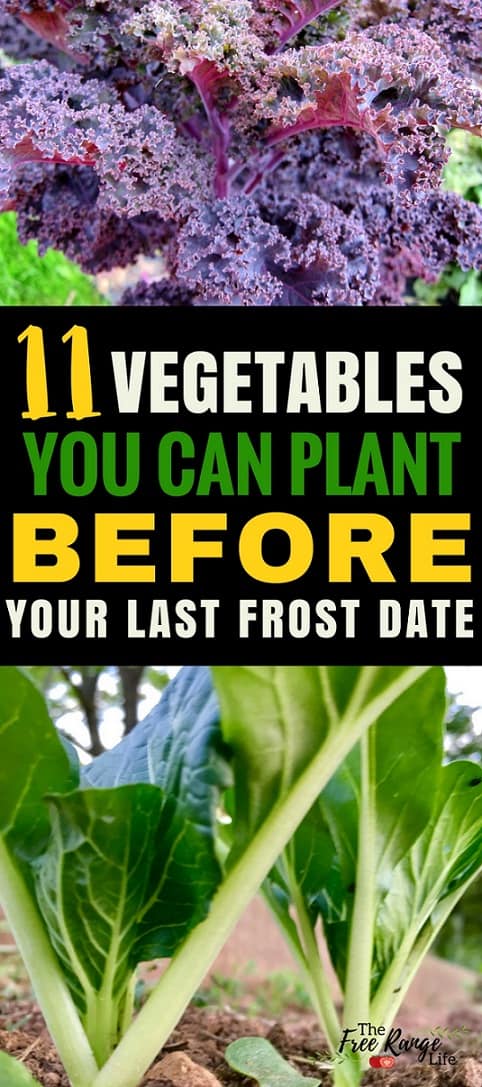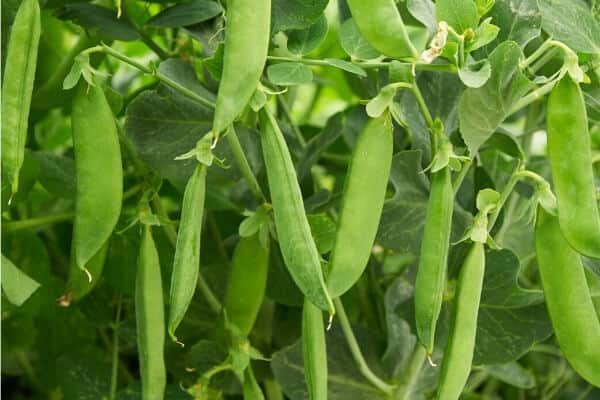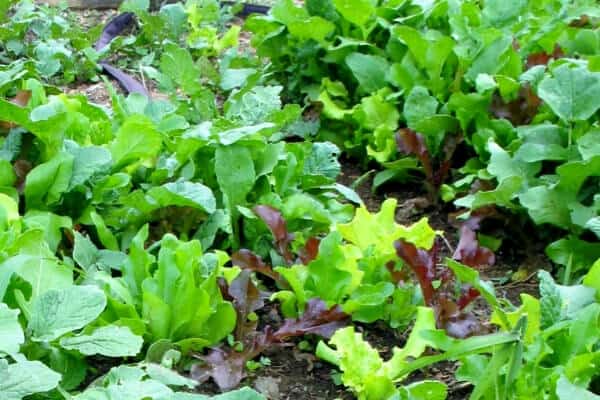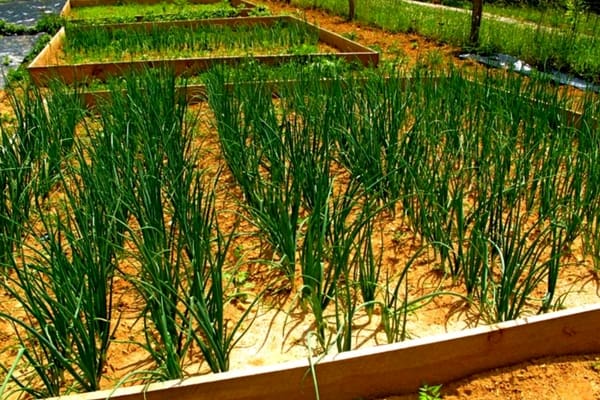You know how it is, the winter seems to drag on forever and you are itching to go and dig in the dirt and plant your garden. Now, it’s bad to jump the gun and plant warm weather crops early, but you don’t have to wait until the last frost to plant your garden!
There are a lot of cool weather vegetables you can plant out before your last frost date. So, as soon as your can work your soil, get out there and start planting!
This site contains affiliate links. If you make a purchase using one of these links, I may earn a commission. Please see my disclosure page for more information about cookies collected and our privacy policy.
Cool Weather Crops to Plant BEFORE Your Last Frost Date!
Peas
Peas are one of my very favorite cool weather crops. They are easy to grow (here’s how to grow them) and they are the most delicious thing.
I like to pre-sprout my peas seeds to make sure I get a good germination rate, but you can also directly sow them in the garden.
Pea seedlings can withstand temperatures of about 28F. They can handle as low as 20F with some potential damage. I have been able to get my peas through a cold snap by covering them with a layer of straw.
And if you get snow- that’s okay! Snow is insulating and will protect them from colder temperatures!
Spinach
Spinach is one of the most cold hardy vegetables and can even be overwintered in many locations with good luck. This cool weather crop can withstand temperatures of 15F!
Spinach does best when sown directly in the garden and you can plant it as early as 4-6 weeks before your last frost date.
Radishes
Radishes are one of the most gratifying vegetables to grow. I mean, seriously, you can have a fresh, homegrown radish from seed in as little as 21 days! When it’s cold and dreary, a bright red radish is sure to brighten your day!
This cool weather crop will germinate in soil temperatures as low as 45. And once growing, the plants can withstand a cold frost.
Don’t forget to plant successive plantings for a longer harvest!
Related Reading: 8 Early Tomato Varieties to Try This Year!
Cabbage
Cabbage is a member of the brassica family and thrives in cool weather.
It’s best to start your cabbage seeds indoors about 8-12 weeks before your last frost date. Once the plants have about 6 true leaves you can transplant them into the garden.
You can start planting out as early as 4 weeks before your last frost date. Cabbages can handle freezing temperatures down to about 20F.
There are even some winter hardy varieties that can be grown through the winters in many gardening zones so plant a second crop in the fall!
Learn How to Grow Cabbage.
Broccoli
Broccoli is another member of the brassica family which loves the cold.
Like cabbage, start your broccoli seeds indoors and transplant to the garden about 4 weeks before your last frost.
Broccoli isn’t *as* hardy as cabbage but can still withstand mid-20s with no problem. If you grown them in a cold frame or under a row cover they can go even colder!
Kale
Kale is a master at withstanding freezing temperatures and there is the added bonus of increased flavor that comes with the frost! Some varieties can even handle single digits.
In the spring, plant your kale indoors at the same time as your broccoli and cabbage.
Another bonus of Kale is that it doesn’t bolt in hot weather as quickly as other cool weather crops. We’ve had kale plants that we planted in February and were still going strong the following November!
Here’s How to Grow Kale.
Arugula
Arugula is a tangy, nutty green that is a member of the brassica family.
Unlike other brassicas, it is best directly sowed in the garden and germinates in temperatures as low as 40F.
Arugula should be sow successively as soon as the soil can be worked and planted throughout the cool weather.
Carrots
Carrots thrive in cooler weather and grow best in daytime temperatures ranging from 60-65F. Carrot seeds should be directly sown in the very early spring, and their seeds will germinate in soil temperatures as low as 55F.
Carrots don’t like hot, so it’s best to plant and harvest before the summer heat.
Carrots also overwinter quite well, so plant a fall crop too!
Here’s how to grow carrots.
Onions
Onions thrive in temperatures between 50-75, but are quite cold hardy as well. This cool weather crop can withstand down to 20F.
Onions need a long growing season to produce a large bulb, so planting early and mulching well to prevent the bulb from freezing (and rotting once thawed) is a must.
Lettuce
Lettuce is a wonderfully, easy thing to grow. Pair it with your spinach, arugula, and radishes for a nice early spring salad.
Depending on your variety, lettuce can be hardy through hard frosts in the low 20s.
Directly sow your seeds in the garden. Frost cloth or row covers may be needed when the seedlings are still small.
Swiss Chard
Swiss Chard is very cold hardy- with some varieties withstanding temperatures of 15F.
You can start your seeds indoors along with your cabbage and broccoli, or direct sow when you plant out your other brassicas.
With proper care and mulch this cool weather crop can be overwintered and will begin to grow again the following spring with no work on your part!
These are, of course, not the only cool weather crops you can grow before you last frost, but they are some of my favorites! So don’t wait- get started gardening now!
You May Also Like:
Complete Guide to Growing Tomatoes
The Best Crops for New Gardeners
How to Grow More Food in Less Time











I love that I can plant so many things before the last frost. Question: What would happen if I directly sow broccoli seeds? Any chance of success?
I have actually done this a time or two. If we have a warm spell for a few weeks that allow the seeds to germinate and get big enough to withstand frost before the next cold snap. Alternately you can cover them with a frost blanket while they are young, as they won’t be as hardy until they are past the seedling stage.
Thank you for sharing your info.
I just found your site. I’m very excited about being able to transplant my veggies I started indoors for the first time. We live in Beaconsfield, Quebec. I didn’t know it could be done so early. Today and for the coming week it’s going to be 50F or higher. I’ll let you know.
Another great crop that can grow before the last frost is beets. In fact, we usually leave them in the ground until we start seeing 20 degree days (October-November). This helps considerably, because we do not have to harvest them while we are busy harvesting everything else.
But what is true in the late season is also true in the early season… Beets do well in cold weather. So much so, that if you plant one crop as soon as the soil is workable, and then harvest and plant another crop that lives through late fall, you can have two crops of beats in a single season.
You forgot garlic
What about pac choy?
Pac choy (bok choy) will bolt if the temperature is below 50 for very long, so it shouldn’t be put out until after the threat of low temps has passed. If your growing season is short, seeds can be started indoors ahead of time with a grow light. We’re in zone 5 and start it indoors at the start of April, roughly 6 weeks ahead of the last frost.
My family once grew Italian radishes, they are now a reoccurring weed in my garden
I live in canada
I sewed zucchini, cucumber and spinach seeds directly into veggie patch a few days ago because it had been warm for a week or 2 and spring seemed well underway, but this morning it snowed and heavy frost is forecast for later in the week. Could the seeds still germinate and grow when it warms up, or is it likely I have killed them?
Thank you